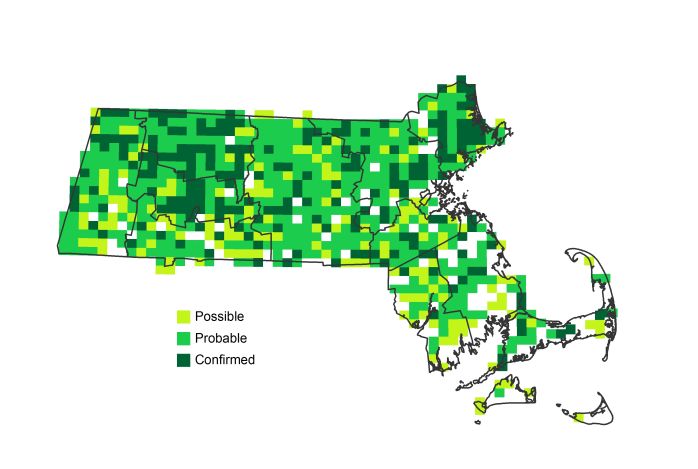Find a Bird
Indigo Bunting
Passerina cyanea

Very widespread and likely increasing
“In the sprout-land beyond the red huckleberry, an indigo-bird, which chirps about me as if it had a nest there. This is a splendid and marked bird, high-colored as is the tanager, looking strange in this latitude. Glowing indigo.” – Henry David Thoreau, Journal
Indigo Buntings are a signature species of fallow or weedy fields and power line rights-of-way – the “sprout-lands,” as Thoreau would have it – where their lusty singing can be heard at all hours of the day throughout much of the summer. While many species that inhabit old fields are declining, the Indigo Bunting seems to be bucking this trend, and has demonstrated an increasing footprint in Massachusetts. With this apparent increase in distribution, however, has come an apparent drop in population – a pattern suggesting that Indigo Buntings may actually be exhibiting the initial stages of decline.
Historic Status
The bright blue of the male Indigo Bunting “makes the mature bird so ornamental to the village scenery,” wrote William Peabody in the mid-nineteenth century, a time of abundance for the species in the state. To Peabody and his contemporaries, the bird was “well known in every garden, where, from the tops of trees, from roofs, and chimneys and lightning rods, we hear his sweet lisping song,” (Peabody 1839). Edward Howe Forbush described the Indigo Bunting as “one of the few useful species seen much about the garden” (Forbush 1907), thanks to their appetite for caterpillars. Alas, the species’ days in Massachusetts were numbered, as the state’s landscape gradually changed from farms to forests during the twentieth century.
Atlas 1 Distribution
As one of the most conspicuous species of shrubland habitat, the Indigo Bunting serves as a useful guide to where healthy shrublands occur. West of the Connecticut River Valley, where forest gaps were common and often large, Indigo Buntings were very widespread. Toward the eastern parts of the Berkshire Transition and Lower Berkshire Hills, their distribution thinned somewhat, although they were generously present in most of the Connecticut River Valley north of the Springfield area. They also had a notable presence in the Lower Worcester Plateau (50%) and Worcester Plateau (64%) regions, and achieved 66% occupancy in the Coastal Plains. Old farms and other abandoned land made the eastern part of the state very attractive to Indigo Buntings, as evidenced by the Boston Basin boasting over 70% occupancy. The Bristol/Narragansett Lowlands had Indigo
Buntings in just over half of all blocks surveyed, but the Cape and Islands had only a thin distribution.
Atlas 2 Distribution and Change
Despite the decreasing trends shown by many scrub-shrub specialists, Indigo Buntings expanded their range in the state during the Atlas interval, and currently they occupy more blocks than they did in Atlas 1. When considering a species that tends to occupy ephemeral habitats such as old fields and young forests, it is important to note that these habitats are frequently maintained by agricultural practices, and in Massachusetts are also created by logging practices. In the far west, Indigo Buntings are at a near saturation point, and it is only in two regions in the state where this species’ gains do not keep pace with losses – the Lower Berkshire Hills and the highly urbanized eastern Boston Basin. The Bristol Lowlands are barely keeping pace with losses in that region. Growth in the number of occupied blocks on the Cape is notable for this species.
Atlas 1 Map

Atlas 2 Map

Atlas Change Map

Ecoregion Data
Atlas 1 | Atlas 2 | Change | ||||||
Ecoregion | # Blocks | % Blocks | % of Range | # Blocks | % Blocks | % of Range | Change in # Blocks | Change in % Blocks |
Taconic Mountains | 14 | 87.5 | 2.4 | 19 | 76.0 | 2.4 | 1 | 6.7 |
Marble Valleys/Housatonic Valley | 37 | 94.9 | 6.4 | 39 | 100.0 | 5.0 | 2 | 5.1 |
Berkshire Highlands | 51 | 92.7 | 8.8 | 54 | 98.2 | 6.9 | 2 | 3.8 |
Lower Berkshire Hills | 23 | 82.1 | 4.0 | 21 | 67.7 | 2.7 | -3 | -11.1 |
Vermont Piedmont | 12 | 70.6 | 2.1 | 17 | 100.0 | 2.2 | 2 | 16.7 |
Berkshire Transition | 19 | 50.0 | 3.3 | 38 | 95.0 | 4.8 | 12 | 38.7 |
Connecticut River Valley | 46 | 82.1 | 7.9 | 57 | 87.7 | 7.3 | 3 | 6.3 |
Worcester Plateau | 50 | 64.1 | 8.6 | 81 | 92.0 | 10.3 | 6 | 12.5 |
Lower Worcester Plateau | 37 | 50.0 | 6.4 | 73 | 91.3 | 9.3 | 19 | 35.2 |
S. New England Coastal Plains and Hills | 177 | 65.6 | 30.6 | 237 | 83.7 | 30.2 | 36 | 15.9 |
Boston Basin | 41 | 73.2 | 7.1 | 33 | 58.9 | 4.2 | -8 | -14.5 |
Bristol and Narragansett Lowlands | 60 | 56.6 | 10.4 | 70 | 61.4 | 8.9 | 8 | 7.9 |
Cape Cod and Islands | 12 | 8.8 | 2.1 | 47 | 32.6 | 6.0 | 26 | 21.7 |
Statewide Total | 579 | 59.8 | 100.0 | 786 | 75.8 | 100.0 | 106 | 12.8 |
Notes
The Indigo Bunting shows a significant decreasing Breeding Bird Survey trend in the Eastern US overall.While Indigo Buntings remain widespread in Massachusetts, their population is showing early signs of decline. Given the negative trends shown by many other young forest species, the Indigo Bunting should be closely monitored in the coming years.



